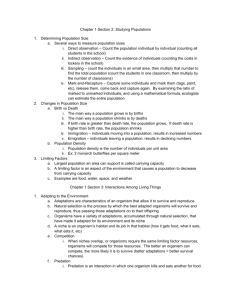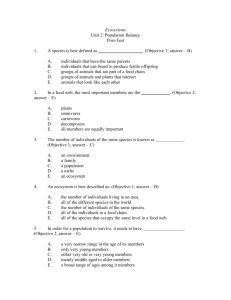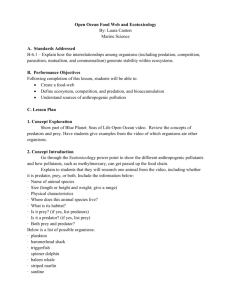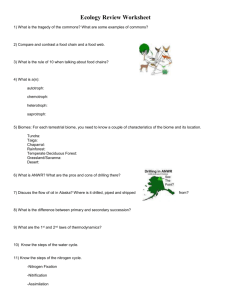Carbon Cycle - Claydon High School
advertisement
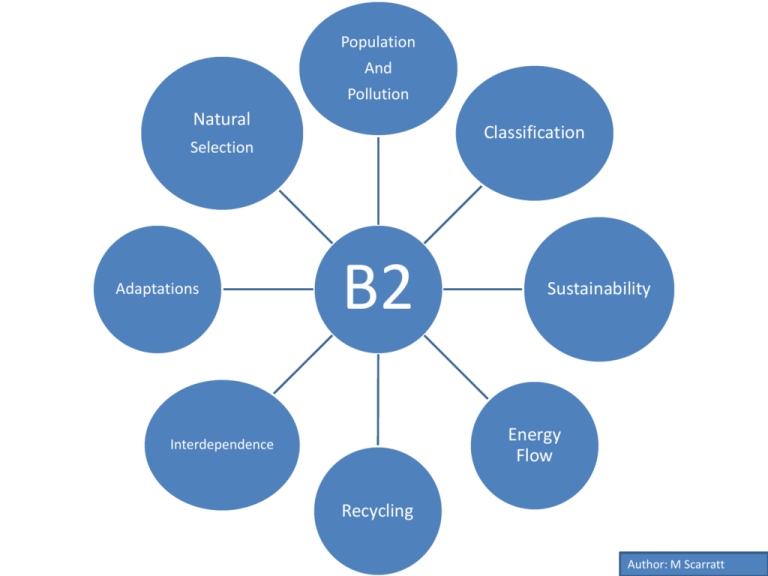
Population And Pollution Natural Classification Selection Adaptations B2 Sustainability Energy Flow Interdependence Recycling Author: M Scarratt Population and Pollution Human Population Pollutants Population is increasing because the birth rate is greater than the death rate. This means that resources are running out: • fossil fuels such as coal, oil and natural gas are being used up rapidly • raw materials such as metal ores and other minerals are being used up rapidly. Pollutant Notes Household waste • Landfill sites – some waste is toxic. • Raw sewage kills aquatic organisms and harms human health. Carbon Dioxide • Released when fossil fuels are used. • Contributes to global warming. Sulphur dioxide • When some fuels are burned sulphur dioxide is released into the air. • This causes acid rain. Water Pollution CFCs Water pollution is caused by the discharge of harmful substances into rivers, lakes and seas. Many aquatic invertebrate animals cannot survive in polluted water Indicator species are in the table below: Level of water pollution clean Indicator species freshwater shrimp high water louse very high Air Pollution mayfly larva low rat-tailed maggot, sludgeworm • Were widely used in aerosol cans, refrigerators and insulating materials. • Caused hole in Ozone layer. Burning of fossil fuels leads to air pollution. Lichens can be used as air pollution indicators, especially of the concentration of sulphur dioxide in the atmosphere. Lichens are plants that grow in exposed places such as rocks or tree bark. For example: bushy lichens need really clean air leafy lichens can survive a small amount of air pollution crusty lichens can survive in more polluted air. HOME Classification Kingdoms Single cell organisms (Ameoba) Arthropods - invertebrates There are several further ranks before we reach a particular species. For a Lion: Insects Animal (6 legs) Protoctists Funghi Aracnids Protoctists (8 legs) Kingdoms Prokaryotes Kingdom •Animal Phylum •Vertebrate Class Anthropods Bacteria Algae Further Division Plant Myriapods Crustaceans (20+ legs) (10-14 legs) Order •Carnivorous Family •Cat Genus •Big Cat Species Species Binomial system A species is a group of organisms that can interbreed to produce fertile offspring. Individuals of the same species have more characteristics in common than they do with organisms of a different species Each species is given a name using Latin words, so that the same name can be used all over the world. •Mammal •Lion Evolutionary Tree species A and B share a common ancestor. Species F and G share a common ancestor, which itself shared a common ancestor with species E.. HOME Sustainability Endangered Species Factors that can cause a species to become extinct include: changes to the environment, such as a change in climate. destruction of habitats. Hunting. Pollution. competition from other species. The Dodo is an example of an extinct species : (hunted + new competitors) A species can become endangered if: the number of available habitats falls below a critical level the population of the species falls below a critical level. Conservation Purpose of conservation is to: maintain the future possibility that plant species might be identified for medicines. keep damage to food chains and food webs to a minimum. protects our future food supply. Problems Whales Many species of whale have been hunted almost to extinction. Whales are a valuable source of raw materials such as whale oil which was used as a fuel in the past. It is hard to protect Whales through conservation. Fish are an important part of the human diet, accounting for a worldwide average 15 per cent of humans' protein intake. Most of these fish are caught wild, and if fish are caught at a faster rate than the remaining fish can reproduce, the stock of fish will obviously decline. Trying to harvest more fish than the sea can produce is an example of unsustainability. Fish Quotas have been introduced to try and help this issue. Fish Deforestation Deforestation has a number of consequences including: the destruction of forest habitats, endangering many forest-dwelling species Causes soil erosion, as the soil-stabilising effect of tree roots is removed- this leads to barren land and a risk of flooding increased atmospheric pollution - mostly carbon dioxide - as forests are cleared by burning trees a reduction in the amount of photosynthesising vegetation, which increases the levels of carbon dioxide in the atmosphere. 8000BC 2000AD HOME Energy Flow Food Chains - feeding relationships in a habitat. Word Meaning producers Green plants and algae. They make food by photosynthesis. primary consumers Usually eat plant material - they are herbivores. For example rabbits, caterpillars, cows and sheep. secondary consumers Usually eat animal material - they are carnivores. For example cats, dogs and lions. predators prey Food Webs When all the food chains in a habitat are joined up together they form a food web. Kill for food. They are either secondary or tertiary consumers The animals that predators feed on. scavengers decomposers Feed on dead animals. For example, crows, vultures and hyenas are scavengers. Feed on dead and decaying organisms, and on the undigested parts of plant and animal matter in faeces. Biomass Pyramid Biomass means the dry mass of living material at a stage in a food chain. The biomass goes down as you go from one stage to the next, just like the amount of energy. Each level of the pyramid is called a ‘Trophic Level’ It can be difficult to make a pyramid of biomass because: • there may be problems measuring dry biomass • an organism may belong to more than one trophic level, so it cannot easily be represented by one bar. Energy Transfer Some of the available energy goes into growth and the production of offspring. This energy becomes available to the next stage, but most of the available energy is used up in other ways. For example: • energy released by respiration is used for movement and other life processes, and is eventually lost as heat to the surroundings • energy is lost in waste materials, such as faeces. HOME Recycling Carbon Cycle Carbon enters the atmosphere as carbon dioxide from respiration and combustion. Carbon dioxide is absorbed by producers to make carbohydrates in photosynthesis. Animals feed on the plant passing the carbon compounds along the food chain. Most of the carbon is exhaled as carbon dioxide formed during respiration. The animals and plants eventually die. The dead organisms are eaten by decomposers and carbon in bodies is returned to the atmosphere as carbon dioxide. Sometimes decomposition is blocked. The plant and animal material may be available as fossil fuel in the future Nitrogen Cycle Nitrogen gas is converted to nitrate compounds by nitrogenfixing bacteria in soil or root nodules. Lightning also converts nitrogen gas to nitrate compounds. The Haber process converts nitrogen gas into ammonia . Ammonia is converted to nitrates by nitrifying bacteria in the soil. Plants absorb nitrates from the soil and use these to build up proteins. The plant may be eaten by an animal, and its biomass used to produce animal protein Urea and egested material is broken down by decomposers. This results in nitrogen being returned to the soil as ammonia Decomposers also break down the bodies of dead organisms resulting in nitrogen being returned to the soil as ammonia In some conditions denitrifying bacteria in the soil break down nitrates and return nitrogen to the air. This is usually in waterlogged soil. Improving drainage reduces this effect, making the soil more fertile. HOME Interdependence Competition Animals • • • • Predators and Prey mates food water space More prey means predator population grows Prey numbers increase due to fewer predators Plants • light • water • Minerals (for photosynthesis) More predators means fewer prey Predators starve, numbers reduce Mutualism and Parasitism Mutualism In mutualism, both species benefit from their relationship. For example, oxpecker birds eat ticks and larvae infesting the skin of buffalo and other large animals. For this reason oxpeckers are called a cleaner species. Parasitism Parasites are organisms that live on or in a host organism. The parasite benefits from this arrangement, but the host suffers as a result. Fleas are parasites. They live on the skin of other animals and suck their blood. This feeds the flea but weakens the host. HOME Adaptations Cold Climates Hot and dry climates Polar bears are well adapted for survival in the Arctic. Their adaptations include: a white appearance as camouflage from prey on the snow and ice thick layers of fat and fur for insulation against the cold a small surface area to volume ratio, to minimise heat loss a greasy coat that sheds water after swimming large furry feet to distribute their load and increase grip on the ice. Camels live in deserts that are hot and dry during the day, but cold at night. Their adaptations include: large, flat feet to spread their weight on the sand thick fur on the top of the body for shade, and thin fur elsewhere to allow easy heat loss a large surface area to volume ratio to maximise heat loss the ability to go for a long time without water - they don't store water in their humps, but they lose very little through urination and sweating the ability to tolerate body temperatures up to 42°C slit-like nostrils and two rows of eyelashes to help keep sand out. Extremophiles Extremophiles live in very extreme environments. They can survive conditions that would kill most other organisms. The extreme conditions can include: very high or very low temperatures high concentrations of salt in water. Predators and Prey Predators Here are some adaptations that make animals successful predators: built for speed sharp teeth and claws camouflage to avoid being seen by prey eyes to the front of the head to judge size and distance well (binocular vision). Prey Here are some adaptations that help animals avoid being caught as prey: live in groups (herds or shoals) built for speed defences such as poison or stings camouflage to avoid being seen by predators eyes to the side of the head to get a wide field of view (monocular vision). Counter-current heat exchange Penguins and other animals in cold climates need to minimise their heat loss. This arrangement reduces the overall loss of heat from the body. HOME Natural Selection Darwin’s Theory of Natural Selection Key points of evolution by natural selection: Charles Darwin 1809-1882 individuals in a species show a wide range of variation this variation is because of differences in their genes individuals with characteristics most suited to the environment are more likely to survive and reproduce the genes that allow these individuals to be successful are passed to their offspring. Controversy Some people do not believe the theory. Some of the reasons for this include: Evolution The basic idea behind the theory of evolution is that all the different species have developed over time from simple life forms. • Darwin’s theory conflicted with religious views that God had made all the animals and plants on Earth • Darwin did not have enough evidence at the time to convince many scientists • It was 50 years after Darwin’s theory was published that the way that inheritance and variation worked was discovered • the genes that allow these individuals to be successful are passed to their offspring. HOME


